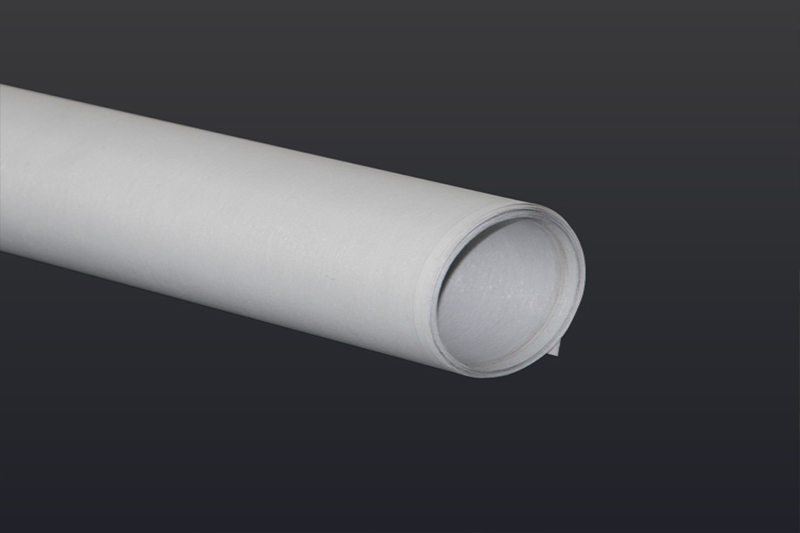In the design, manufacturing, and maintenance of motors, the insulation system directly determines performance, reliability, and service life. Motor insulation paper is a key component of this system, and selecting the right material is critical. In the motor industry, DMD, DM, and DMDM are three of the most commonly used insulation papers.
What exactly are their structures? What are the differences among them? How should companies or engineers choose the right one? This article provides a comprehensive explanation.
DMD insulation paper is a three-layer composite consisting of polyester film (D), synthetic fiber paper (M), and polyester film (D).
It is the most widely used composite insulation paper today. The middle synthetic fiber layer provides mechanical strength, varnish absorption, and heat dissipation, while the polyester film layers on both sides provide electrical insulation strength and moisture resistance.
Thermal Class: Common thermal classes are F-class (155°C) and B-class (130°C). When high-performance aramid paper and high-temperature polyester films are used, DMD insulation paper can reach H-class (180°C).
Main Applications:
DMD insulation paper is used in general motors, small and medium-sized generators, transformers, and electrical instruments. In these applications, it serves as slot insulation, interturn insulation, and interlayer insulation, offering an excellent cost-performance ratio.

DM insulation paper is a two-layer composite made of polyester film (D) and synthetic fiber paper (M).
Compared with DMD insulation paper, DM has only two layers. One side is polyester film, which provides electrical insulation performance. The other side is fiber paper, which makes forming and wrapping operations easier for technicians. It adheres well to coils and has excellent varnish absorption during the impregnation process.
Thermal Class: DM insulation paper is mainly available in B-class (130°C) and F-class (155°C).
Main Applications:
DM insulation paper is suitable for parts of a motor that require high bending performance. It can also be used as lead insulation and padding insulation. Because one side is soft and flexible, it is ideal for single-sided adhesion or bonding to irregular surfaces.
DMDM insulation paper is an enhanced version of DMD insulation paper, typically featuring a thicker multi-layer composite structure, such as a “D + M + D + M” configuration.
Manufacturers increase the number of layers to significantly improve the overall thickness, mechanical strength, and electrical strength of the material. It has strong mechanical toughness and puncture resistance, allowing it to withstand demanding processing conditions and harsh operating environments.
Main Applications:
DMDM insulation paper is used in large high-voltage motors, special-purpose motors, traction motors, and electrical equipment operating in harsh environments. It is suitable for applications where extremely high reliability and durability of the insulation system are required.

When selecting motor insulation paper, you should consider the following factors:
Thermal Class:
This is the primary criterion. First determine the motor’s designed or operating temperature rise class B, F, or H, then choose insulation paper that meets or exceeds that class.
Electrical Strength:
Based on the motor’s operating voltage, ensure that the breakdown voltage of the insulation paper meets the application requirements. DMD and DMDM insulation papers show stable performance in high-voltage environments.
Mechanical Properties:
Choose insulation paper according to the motor’s manufacturing process (such as automatic winding), as well as the electromagnetic forces and vibration encountered during operation. When high mechanical strength is required, DMDM insulation paper should be selected.
Thickness and Space:
In compact motor designs, engineers must balance insulation performance with space limitations. DM insulation paper and standard DMD insulation paper occupy less space.
Budget:
For conventional applications, DMD insulation paper offers the best cost-performance ratio. When the budget allows and extremely high insulation reliability is required, DMDM insulation paper is the recommended option.

Q1: Is the “M” layer in DMD insulation paper always made of aramid paper?
A1: Not necessarily. In high-end and mainstream DMD insulation products, manufacturers often use DuPont™ Nomex® aramid paper because it provides excellent thermal resistance and mechanical performance. However, some economical DMD products may use other types of synthetic fiber paper.
Q2: Can these three types of insulation paper replace one another?
A2: If the thermal class and electrical properties meet the application requirements, upward compatibility is possible (e.g., using DMDM insulation paper to replace DMD). However, downward replacement is not recommended. Consult a professional engineer for specific substitutions, as changes in thickness and flexibility may affect motor design and performance.
Q3: Where can I purchase high-quality DMD/DM/DMDM insulation paper?
A3: It is recommended to purchase directly from insulation paper manufacturers to ensure genuine and reliable materials.
DM, DMD, and DMDM are fundamental materials in the motor insulation field. Understanding their structural differences and performance characteristics is key to proper selection, optimized motor design, and ensuring long-term stable operation of the equipment.
If you need our products please write down any questions, we will reply as soon as possible.
There are three ISO certificates for quality certification. The certificates will be shown later. ISO
After receiving the advance payment, the production cycle is 15-25 days. And the transportation cycle should be calcul……
We supply with installation guide and user manual for each transformer. If you do not understand them. We will offer v……